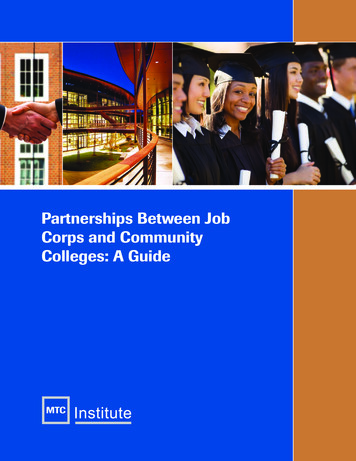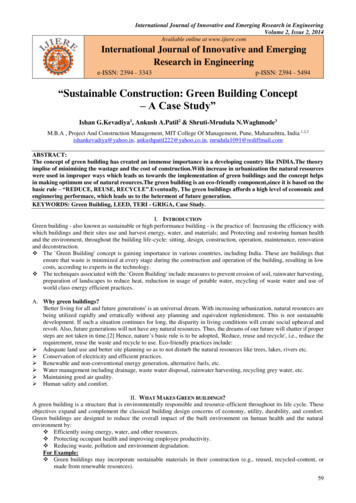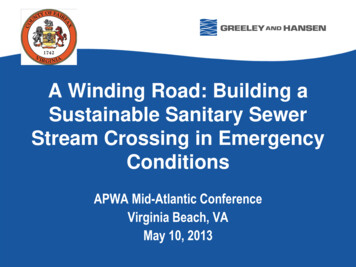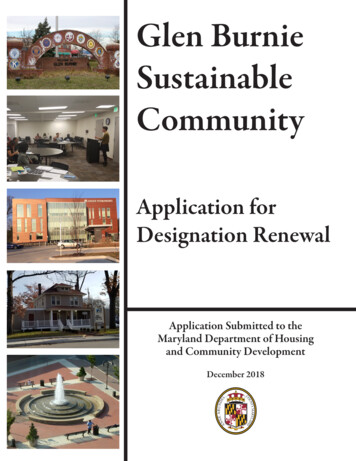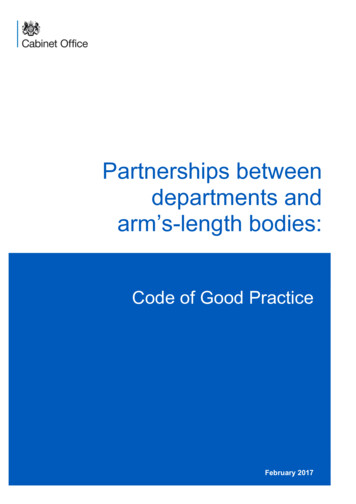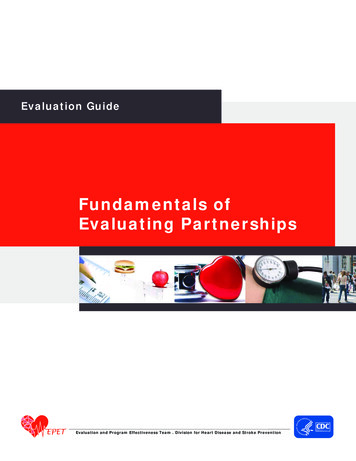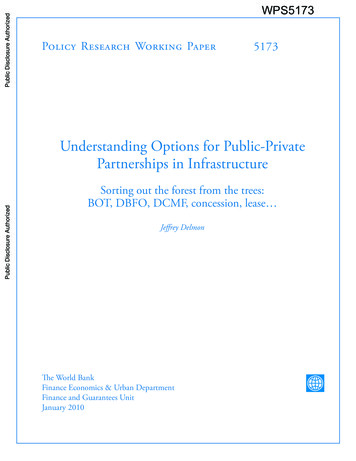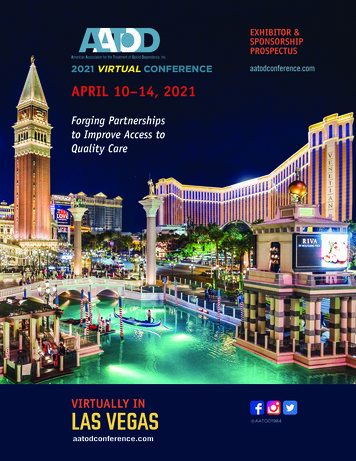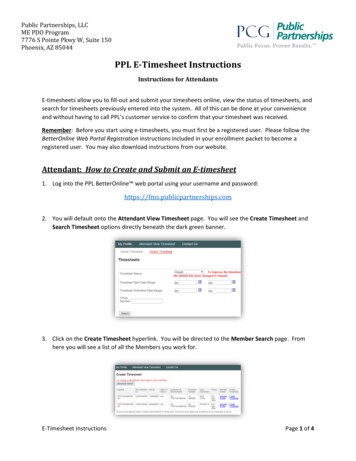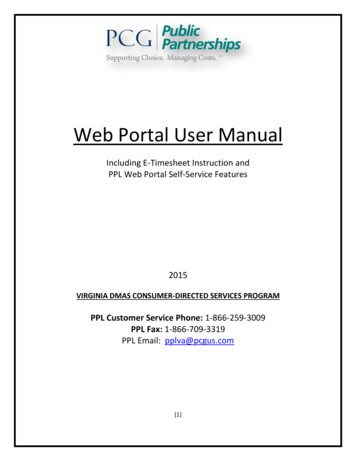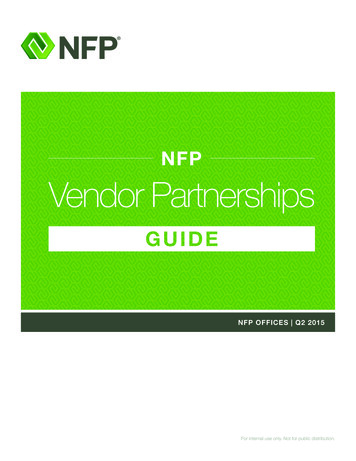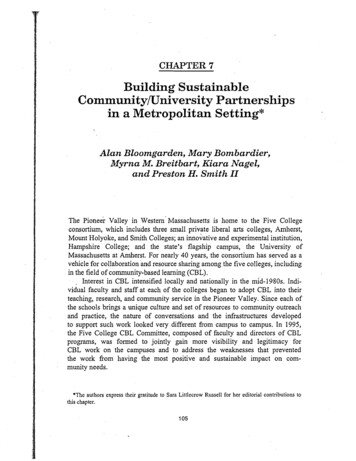
Transcription
CHAPTER 7Building SustainableCommunity/University Partnershipsin a Metropolitan Setting*Alan Bloomgarden, Mary Bombardier,Myrna M. Breitbart, Kiara Nagel,and Preston H. Smith 11The pioneer Valley in western' Massachusetts is home to the Five Collegeconsortium, which includes three small private liberal arts colleges, Amherst,Mount Holyoke, and Smith Colleges; an innovative and experimental institution,Hampshire College; and the state's flagship campus, the University ofMassachusetts at Amherst. For nearly 40 years, the consortium has served as avehicle for collaboration and resource sharing among the five colleges, includingin the field of community-based learning (CBL).Interest in CBL intensified locally and nationally in the mid-1980s. Individual faculty and staff at each of the colleges began to adopt CBL into theirteaching, research, and community service in the Pioneer Valley. Since each ofthe schools brings a unique culture and set of resources to community outreachand practice, the nature of conversations and the infrastructures developedto support such work looked very different from campus to campus. In 1995,the Five College CBL Committee, composed of faculty and directors of CBLprograms, was formed to jointly gain more visibility and legitimacy forCBL work on the campuses and to address the weaknesses that preventedthe work from having the most positive and sustainable impact on community needs.*The authors express their gratitude to Sara Littlecrow Russell for her editorial contributions tothischapter.
106 /INSIDE AND OUT,Although some reciprocal projects had been created over the years betweenthe area colleges and community organizations, up to that point the majority ofrelationships were imbalanced, providing more benefits to student learning andcollege public relations than to community organizations. Community partnersfaced constant requests from colleges for research sites, short-term internships ororientations to the community, yet our institutions remained ill-prepared andill-equipped to respond to requests for sustained assistance. Poor commudicationamong the colleges duplicated efforts and demanded even more from alreadyoverburdened community organizations.In its first years, the CBL Committee hosted several faculty workshops,introducing concepts and successful models in CBL to encourage more facultymembers to get involved and to foster relationships among them and nonprofit leaders. In 1999-2000, Hampshire College hosted a Five College seminarfunded by the Teagle Foundation, providing course development granis forfaculty at all five institutions. Collaborative facilitation and teaching in theseminar helped to solidify common goals, yield future projects, and fostercommunity/campus dialogue. In January 2001, a fonun that was speciallydesigned to further dialogue featured Ken Reardon, a professor of urban planningat Cornell University who has done groundbreaking work in this field (Reardon,1994, 1998).More than 50 community leaders came to Hampshire College's eventsvenue, the Red Barn, to share with an equal number of facul'ty and staff from thecolleges the message to "get our act together" with regard td collaboration. CarlosVega of Nueva Esperanza, a community development corporation in Holyoke,recounted how he had spent many hours being interviewed by students notconnected with each other or each other's work, who time and again reinvented.their inquiry into Holyoke's history and the city's Latino community. Whilehe generously provided the students with time as a long-term investment in hisorganization's relationship with the area colleges, when he asked the studentsfor their papers at the end of the semester, "about half of them gave me thepaper and the other half, I never saw again." Participants in the forum respondedby calling for the design of more efficient and effective means of college andcommunity interaction and greater transparency in the processes and opportunities for accessing college resources, such as internships, faculty research, andcollaborative grants. We asked Nueva Esperanza and other community-basedorganizations (CBO's) how we might make better use of student research hoursfor community needs, without compromising students' achievement of theiracademic goals. Could such processes simultaneously value and strengthen theknowledge and skills of community leaders? Could we find ways to bettercoordinate the CBL efforts for a higher degree of community benefit? Ultimately, we were led to question what we were seeking to achieve by thiscollege/community collaboration.
BUILDING SUSTAINABLE PARTNERSHIPS / 107COMMUNITY/COLLEGE PARTNERSHIPS:GUIDANCE.FROM THE LITERATUREMuch of the literature on college/community partnerships begins bydefending and promoting the idea of an "engaged" institution of higher learningand the practice of "civic responsibility7'as an institutional rather than individualobligation to enhance community capacity (Dugery & Knowles, 2003; Holland,2001; Ramaley, 2000). If one of the aims of a partnership is to enhance communitycapacity, we would ask, "capacity to do what?" Is the goal to enable communitypartners?to enter more effectively into service-learning partnerships with institutions of higher learning or to meet some other criteria with respect to addressingcritical local needs? Are those goals mutually exclusive or dependent upon oneanother? Literature on community/college partnerships is rarely explicit aboutthe goals (suggesting mainly that partners agree on them). Yet goals can rangefrom creating opportunities for students and faculty to become better citizenswhile communities better understand their problems, to striving for full-scalesocietal change and social justice.Although there is little attention focused on specific goals, partnershipliterature does identify institutional practices that both create obstacles to andfurther college-community relationships (see for example, Leiderman et al., 2003;Perkins & Wandersman, 1990; Silka, 2001). For example, academic cultures thatmarginalize applied research and learning outside the classroom and the distinctcultures of institutions of higher education and the communities that surroundthem, are frequently cited as obstacles (Ramaley, 2000; Sandmann & BakerClark, 1997). Focusing our attention on the power and resource discrepanciesbetween academic institutions and community entities, Compton critiques thisidea of borders, believing that it obscures recognition of unequal distributions ofresources and power among partners (2003, pp. 10-11).Based on Cruz and Giles' understanding of partnerships as a means to alarger end-greater social justice--one of our goals is to increase communityaccess to resources to address the inequities in resource distribution betweencolleges and community-based organizations serving low-income populations.Resonant with Cruz and Giles, we assess the success of partnerships by askingtwo key questions: Is the service, the learning, or the ability to address localneeds better because of the partnership? And has the community identified moreassets and acquired greater access to resources (Cruz & Giles, 2000, p. 31)? Byattempting to correct the imbalance of resources in our partnership relationships,we consider how participatory regional community development might enable acommunity-defined agenda to emerge and accommodate diverse priorities amongyour CBO partners and among our diverse institutions of higher education.Much of the literature focuses on markers of good CBL practice, such asrelationship and trust building at all stages of the process (but especially in the
108 1 INSIDE AND OUT*,earliest stage of partnership development); shared control of the partnership andits continual reassessment; respect for diverse knowledge (academic/theoreticalvs. practical/experiential); accountability on the part of academic partners inworking with the community; the integration of community partners into campuslife and preparation of faculty and students for community-based work; along-term sustainable commitment of resources and positive outcomes for allparties involved (Campus Compact, 2003).The adoption of the these markers suggests that more institutions of highereducation are seeking greater reciprocity and are abandoning the practice ofimposing academic-defined problems on communities or utilizing the resources ofcommunity-based organizations without providing much in return. However, eventhis literature on relationship development tends to focus on the constructionof limited partnerships between a single institution of higher education- cand asingle (or a few) community-based organizations. In contrast, the Five Collegeconsortium is a "loose" collaboration in which institutions retain distinct authorityover policies and the commitment of resources. The recent addition of HolyokeCommunity College (HCC) into this planning group introduces even more complexities for what has become known as the Holyoke Planning Network (HPN).Currently, HPN involves six institutions of higher learning (all but one ofwhich reside outside the geographic limits of the community) and a multitude ofcommunity-based organizations. As we Qove beyond a phal;e of initial relationship development to utilizing the best practices of CBL id the construction ofalliances among the colleges and CBOs, this situation presents many challengesand opportunities. Addressing the power differentials in terms of access toresources occupies a considerable amount of our time even while we seek waysto generate more resources to address critical community needs. Our interest.in considering how community/college partnerships might promote greaterequalization of power and resources through joint research, projects, and socialactions, leads us to the primary issues we address here:(How do we build a regional coalition among institutions that supportvarying levels and types of activity in the city of Holyoke?How can we most effectively pursue institutional buy-in fiom institutions atdifferent levels, through different processes, and within different timeframes?How can pamerships promote the acquisition of resources for communitypartners and further community control of those resources while alsopromoting the campus acquisition of new knowledge and innovative pedagogical practices?How can we create mechanisms for college administrators, development officers, and potential partnership fimders that acknowledge theprovision of community resources that will enrich student learning andfaculty research?
BUILDING SUSTAINABLE PARTNERSHIPS / 109INITIAL EFFORTS TO FORGECOLLEGE/COMMUNITY LINKAGESSince addressing CBL problems of practice was a parallel priority toadvancing CBL as a component of campus teaching and research, we beganearly on to design concrete projects that would create a more coordinated infrastructure among our institutions. They included coordinating training andtransportation for students, creating community access and transportation to ourcampuses, and increasing outreach. As an additional measure, a CBL Web sitewas desl\gned. Our next priority became the development and implementationof good practice with an appropriate subset of community partners.Holyoke was the obvious location for our coordination efforts because itwas the city where each of the Five Colleges and HCC had placed hundredsof student interns, launched several large research projects, and interviewedmany community members and organizations. Countless research papers hadbeen written about Holyoke on subjects as wide ranging as analyses of asthmaprevalence and mental health issues, assessments of affordable housing andhealthcare access, and investigations into the impact of systemic racism andmultigenerational poverty. In spite of this research and the efforts of individualson the various campuses to address the issue of reciprocity, Holyoke nonprofitscontinued to struggle for survival in an environment of fiscal cutbacks. At itsmost fundamental elements, the process of researching the Holyoke communityremained inequitable.Holyoke is a compelling place to research and serve because it is one ofthe poorest cities in Massachusetts, yet has many untapped assets. It currentlyprovides jobs for many residents who live (and pay taxes) in borderingtowns and is a resource to area colleges (who also do not pay taxes to the city).From our perspective, there was and is a potential for natural reciprocity, asyet unrealized. Area educational institutions already had a stake in Holyoke'seconomic health, and an economically healthy Holyoke would reward theseinstitutions by greatly enhancing the colleges' attractiveness as institutionsof higher learning. In a successful community/college partnership, we wouldplay a crucial role in lending intellectual and human capital to economic development efforts. HPN's role would be to help our educational institutionsunderstand that sharing resources with Holyoke's CBOs is working toward acommon goal of revitalization, addressing the city's problems and building uponits assets.Planning the Planners Network ConferenceHPN wanted to evolve from holding seminars to effecting similar changes towhat Ken Reardon and the University of Illinois had spearheaded in East St. Louis(Reardon, 1994, 1998). Reardon was also a member of the national steeringcommittee of the Planners Network, an association of professionals, activists,
110 /INSIDE AND OUTacademics, and students who use planning as a tool for strategically allocatingresources to promote fundamental change at the urban basis of our politicaland economic systems. When he approached Hampshire College's CommunityPartnerships for Social Change Program (CPSC) to host the 2002 PlannersNetwork conference in Western Massachusetts, CPSC director Mary Bombardier,Professor Myrna Breitbart, and CPSC Program Coordinator Kiara Nagel Faw theconference as a springboard for current community-based learning effofts and asan opportunity to create an innovative model of accountability and collaborationamong members of the academic community and representatives from theHolyoke nonprofit community.With its strong history of social commitment, Hampshire College supportedCPSC, to lead in the creation of this innovative model of educational partnershipin conjunction with leaders from Holyoke's nonprofit community, the H l y o k eOffice of Planning, and faculty and staff from area colleges. Nueva Esperanza,a community development organization in Holyoke with a long-standing relationship to CPSC, was approached to be the lead community organization andwork with academic partners to create a steering committee. The steering committee created a conference vision and planned the details for a national gatheringin Holyoke.From the outset, our organizing circle sought to break down traditionalcommunity/campus boundaries. We worked daily to develpp a decision-makingprocess that respected each person's opinions with equal weight without beinginfluenced by the notions of status or power that exist in academia, city governments, and most nonprofits. Our meetings often began as brainstorming sessionsand ended up as graphic depictions of the intense struggles that community leadershave faced in the last 20 years of working in Holyoke. These conversations were- critical to rebuilding trust and establishing relationships among socially andeconomically disparate groups; they also forged a unified vision for change. Underthis vision, we hoped to use the conference to:Explore new solutions to old problems, address barriers to change,and create a collaborative new vision for the city of Holyoke and itssurroundings.Showcase Holyoke and the innovative work of community-based organizations, articulate their specific planning and organizing needs, andengage in dialogue about these self-identified needs with local and nationalconsultants.'Develop effective working relationships.Conference Highlights"New Visions for Historic Cities: Bridging Divides, Building Futures" tookplace in June 2002. It included no scholarly lectures or theoretical papers. Instead,
BUILDING SUSTAINABLE PARTNERSHIPS / 111there were vibrant panels, workshops, and activities, each carefully structuredto balance the representation of academics and community organizers. A bus touroriented participants to Holyoke and its diverse neighborhoods and issues.Site visits allowed participants to dialogue with community members and seeinnovative neighborhood projects firsthand. A local theater group performed aplay on the industrial history of the city and its canals. A featured artist introducedthe keynote speaker with a poem. A local teen sang the U.S. and Puerto Ricannational anthems. Throughout the conference, national perspectives and issueswere balanced by local ones, academic standpoints with community views. Thedialogue ,was rich and multilayered. Late one evening, as an 11-piece salsa bandplayed, the relationships that the conference had renewed and revisioned betweenthe academic community and the people of Holyoke erupted into an enthusiasticintergenerational version of the Electric Slide, and the dance floor was filledwith laughing steering-committee members, urban planners, college professors,students, teens, and Holyoke families.The most important long-term effect of the conference was a powerfuldemonstration of coalition building supported at its foundation by a commitmentto an equitable planning process. By collaboratively creating a conference of manyvoices, the very planning process presented a model for how we wanted ouracademic iinstitutions to engage with the Holyoke community. As such, theconference not only laid a foundation .for increased cooperation amongHampshire, Mount Holyoke, Smith, Amherst and UMass Arnherst, but alsoprovided a model for these institutions to work collaboratively in the communityof Holyoke.The visible success of the National Planners Network conference inspiredmany people to harness the momentum and incorporate lessons into new modelsof community-based learning and partnerships. The steering committee continuedtomeet and was joined by representatives from other local colleges, the university,and Holyoke-based organizations. The profound and lasting partnerships withcommunity-based organizations in South Holyoke have continued to evolve underthe name of the HPN. As the Network seeks to secure funding and academicadministrative commitments to this planning work, tension is fed by competitionfor resources, lack of focus, unclear priorities, and the dismal economic climate.The challenge of reconciling the priorities of academic institutions with thoseof the community still remains large and threatens the fragile trust that theconference planning was able to create.As Five College CBL faculty and staff continued to explore metropolitanissues with community partners, questions of resources and institutional buy-in forenhanced community partnership in Holyoke came up in two related contexts.These contexts were the development of a HUD Community Outreach PartnershipCenter (COPC) grant and building the relationship between HCC and the FiveCollege consortium.
112 /INSIDE AND OUTTHE HUD COPC PROPOSAL PROCESSHPN began planning for a HUD COPC grant to focus our community1university dialogue on the partnership goal of creating a permanent physicalpresence in Holyoke as a means to sustain reciprocal community and educational programming. From the perspective of community organizations, COPCfunds and the accompanying structural relations between higher educatibn andcommunity partners mandated by the grant's operating environment (a solid,matching-funds supported infrastructure) promised real cash and partnershipactivities with equally real potential to address community challenges by buildingon Holyoke's assets. From the perspective of academic partners, a COPC framework promised a focal point for an institutionallcity p
More than 50 community leaders came to Hampshire College's events venue, the Red Barn, to share with an equal number of facul'ty and staff from the colleges the message to "get our act together" with regard td collaboration. Carlos Vega of Nueva Esp
